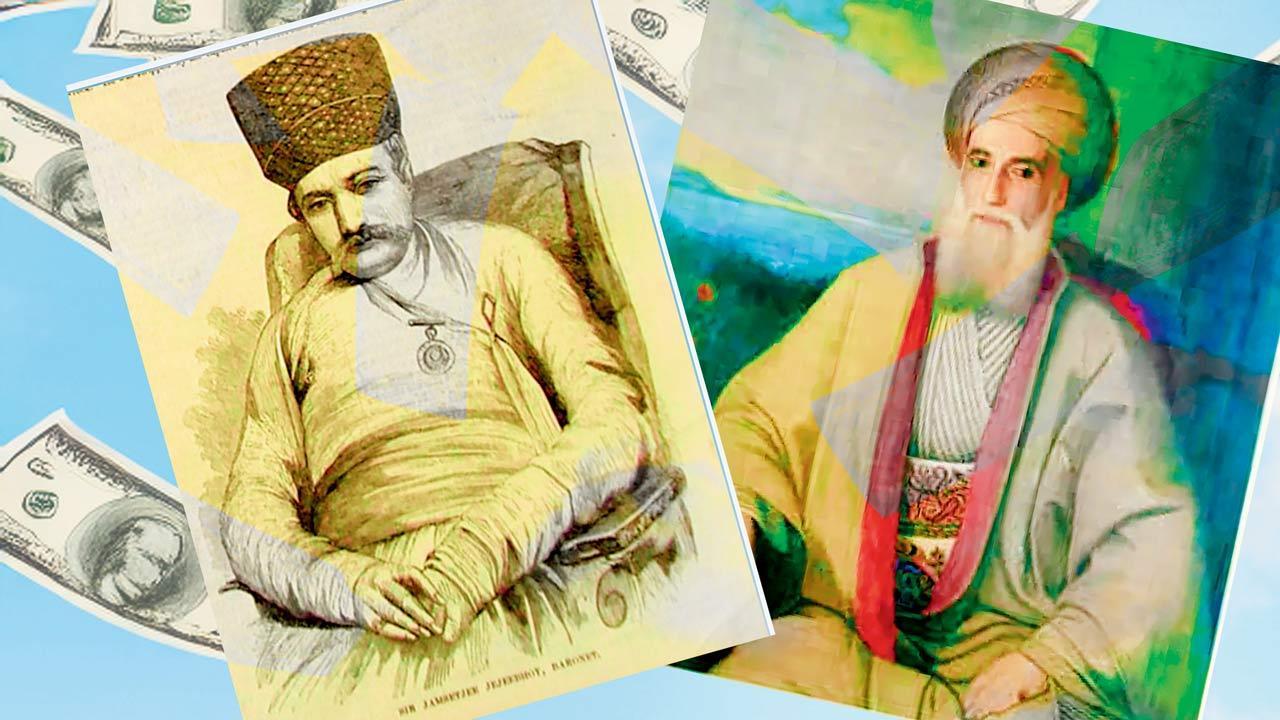It was another Mumbai party and the discussion was about wealth, greed and generosity. Two legendary philanthropes were indicted

Philanthropes Jamsetjee Jeejeebhoy (left) and David Sassoon. Illustration by C Y Gopinath using Midjourney
 I knew that if I waited any longer, they’d start the karaoke and then there’d be no turning back. So I interrupted the party with the disruptive question I had been nursing since early evening.
I knew that if I waited any longer, they’d start the karaoke and then there’d be no turning back. So I interrupted the party with the disruptive question I had been nursing since early evening.
ADVERTISEMENT
“Which of these two gentlemen gave more to Bombay, Jamsetjee Jeejeebhoy or David Sassoon?”
It wasn’t a random question. A few days earlier, a video had been making the rounds of WhatsApp, in which a jolly fellow called R N Bhaskar explains that David Sassoon was really the man who made Bombay rich, even though most people didn’t know it.
However, when I aired this factoid at another party, they looked at me as if I was crazy.
“What are you saying?” exclaimed a tenor. “Everybody knows it was Jamsetjee Jeejeebhoy.”
So I asked my new question at a new party. You could say I’m a party animal.
There was a moment’s silence and then everybody started talking all at once. Everyone but my humble self seemed to know Bombay’s history in cinematic detail, replete with dates, places and little-known facts.
“You can’t choose between them,” said a fish merchant.
Both JJ and DS, I learned, were very good at what they did, which was making money. Jeejeebhoy, born to a poor Parsi family in 1783, sold empty bottles in his uncle’s shop until he discovered that there was money to be made selling opium to China, where there were millions of addicts.
“He’d have been called a drug cartel today,” said a baritone. “The US Drug Enforcement Agency would have been all over him.”
David Sassoon, a Baghdadi Jew who was chief treasurer to the pashas, fled to Bombay to escape the persecution of Jews by Iraqi governor Dawud Pasha. Seeing how well the Parsis were doing with selling opium and textiles to China, he muscled in on the operation and pretty soon he was a cartel too. He sold Indian yarn and opium to China, where he bought goods that he sold in Britain, from where he brought back Lancashire cotton to India to make more products to sell to Britain.
So we have two gentlemen wealthy from selling drugs to addicts. Both, it seems, gave back abundantly. Jeejeebhoy, who understood poverty, gave across religions and communities and contributed to the city’s infrastructure. He built the Mahim causeway, connecting the islands of Mahim and Bandra. A hospital, and schools of art and architecture still stand in his name. In 1822, he helped launch a major newspaper, Bombay Samachar, and 16 years later, Bombay Times which evolved into The Times of India.
The J J Dharamshala at Bellasis Road, where the aged and the destitute received free food, shelter, clothing and medicines, was the first of its kind in Bombay.
Sassoon, no lightweight either, built the David Sassoon Library & Reading Room, still an iconic landmark, and various synagogues, schools and hospitals. Unlike Jeejeebhoy, who was tight with the British and had even been knighted by the Queen, Sassoon refused to speak anything but Arabic and Hebrew. The British gave Jeejeebhoy dockyard space from one end of the islands to the other—so Sassoon built his own, the legendary Sassoon Docks, the first one with railway tracks going all the way to the ships.
The two put their money into the Gateway of India, the clock tower at Victoria Gardens (now Jijamata Udyan) and the Victoria and Albert Museum (now the Dr Bhau Daji
Lad Museum).
So who made Bombay richer?
“That wasn’t your question,” a fish merchant said. “You asked who gave more to this city.”
“It’s impossible to answer that,” said the tenor. “They weren’t competing and no one was counting how much they spent.”
“One thing for sure, Uncle Bhaskar’s WhatsApp video was wrong to say it was only Sassoon,” declared a retired sub-editor.
“Sassoon was mainly interested in expanding his business empire,” said a Buddhist scholar. “Jeejeebhoy gave selflessly, expecting nothing in return. That’s real giving. I vote Jeejeebhoy.”
“Sassoon!” said the baritone.
Before they came to blows, I changed my question. “May we ask who benefited more people, Jeejeebhoy or Sassoon?”
“That’s easy,” said the baritone. “It was clearly Sassoon. He built 17 mills and employed over 20,000 mill workers. That’s real benefit.”
Who knew David Sassoon was the unwitting father of the mall district at Lower Parel?
“Are you saying that it’s only true giving if you don’t benefit from it?” I asked. “Jeejeebhoy lived in a palatial mansion, you know.”
“He has to live somewhere,” said the Buddhist. “At least he didn’t build a funny-looking skyscraper.”
“They hadn’t invented skyscrapers yet,” said the tenor.
“Wait,” said the fish merchant. “The Jeejeebhoys gave for eight generations and are still philanthropes. The Sassoons disappeared once they set up shop in Shanghai and Hong Kong.”
It was beginning to look like a tie. Both JJ and DS were rich, both made money off drug addicts, both gave back a lot, but one went global while the
other stayed local.
It was a good moment to throw a new question into the mix. “Does anyone know how much they spent on their son’s wedding?”
But it was too late by then. The karaoke had begun.
You can reach C Y Gopinath at cygopi@gmail.com
Send your feedback to mailbag@mid-day.com
The views expressed in this column are the individual’s and don’t represent those of the paper
 Subscribe today by clicking the link and stay updated with the latest news!" Click here!
Subscribe today by clicking the link and stay updated with the latest news!" Click here!







